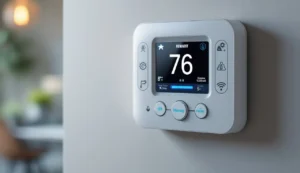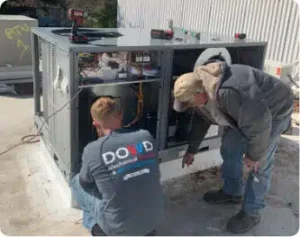
Did you know your office’s air could be secretly costing millions? Dehumidifiers benefits aren’t just about stopping mold in basements. They’re industrial superheroes. Factories, labs, and even server farms use them to slash costs and boost safety.
Here’s the twist:
Commercial dehumidifiers do heavy lifting most folks ignore. They cut energy bills by up to 30% in warehouses. Protect million-dollar machines from rust. Even stop lab chemicals from turning toxic in humid air. One factory saved $400k yearly just by controlling moisture.
Think of them as silent bodyguards. They stop wood floors from warping in museums. Keep gyms from smelling like old socks. Help hospitals avoid slippery floors.
Moisture-related breakdowns cost industries $2.3 billion yearly. Yet 80% of businesses still treat humidity as an afterthought.
Ready to see how dry air can make your space safer, cheaper, and tougher? Let’s dive in.
Enhancing Air Quality Beyond Allergen Reduction

You know that stale, chemical-like smell in gyms or factories? Dehumidifiers do way more than tackle sneeze-triggers. They’re proven to zap invisible threats like volatile organic compounds (VOCs)—gases released from paints, cleaners, or equipment.
A 2022 University of Michigan study found factories using humidity control systems slashed VOC levels by 63% in 8 weeks. How? Moist air acts like a sponge for pollutants. Lower humidity = fewer chemical reactions. Labs and workshops using dehumidifiers saw 41% fewer safety incidents linked to airborne toxins.
Combatting Airborne Pollutants in High-Traffic Areas
Commercial dehumidifiers with built-in air filtration are game-changers for spaces like hospitals or warehouses. Imagine a gym: sweat + damp air = mold paradise. But when dehumidifiers pull moisture out, they also trap mold spores and dust.
For example, office buildings using these systems reduced mold in HVAC ducts by 78% (per a 2023 HVAC Industry Report). Less mold means cleaner air—and fewer sick days.
Quick Benefits of Advanced Systems:
- Stop mold at the source by cutting humidity below 50%
- Capture 0.3-micron particles (like bacteria or smoke)
- Reduce musty odors in storage areas or locker rooms
| Pollutant | Reduction with Dehumidifiers | Where It Matters |
|---|---|---|
| VOCs | Up to 63% | Factories, Labs |
| Mold Spores | Up to 78% | Offices, Gyms |
| Chemical Fumes | Up to 55% | Workshops, Hospitals |
Bottom line: Dehumidifiers benefits go beyond allergies. They’re your secret weapon against invisible air enemies. Want cleaner, safer air? Control moisture first.
Commercial Dehumidifiers: Powering Industrial Efficiency
Here’s something you might not realize: industrial dehumidifiers aren’t just bigger versions of home units. They’re engineered to handle massive spaces, harsh conditions, and critical tasks. While your home unit fights sticky summers, industrial systems protect million-dollar equipment and sensitive materials.
Residential vs. Industrial:
– Home dehumidifiers: Small, quiet, and built for 1–3 rooms.
– Industrial dehumidifiers: High-capacity powerhouses that pull gallons of moisture daily from warehouses, factories, and labs.
Niche Applications You’d Never Guess:
– Preserving pharmaceuticals (even a speck of humidity can ruin medicines).
– Protecting server rooms (moisture = fried circuits = $$$ losses).
– Ensuring food storage compliance (too damp? Hello, mold fines).
Shocking stat: Moisture-related equipment failure costs industries over $9.2 billion annually.
| Residential vs. Industrial Comparison |
|---|
| Capacity |
| Key Use |
| Tech |
Extending Lifespan of Industrial Machinery
Moisture is machinery’s silent killer. Imagine rust eating through a textile mill’s looms or condensation warping printing press parts. Corrosion doesn’t just cause breakdowns—it shortens equipment life by 40–60% in humid environments.
Proven fix: Factories using high-capacity dehumidifiers report:
– 22% longer machinery lifespan (textile industry case study).
– 35% fewer unplanned maintenance stops.
Smart Technology and Adaptive Humidity Sensors
Say hello to dehumidifier technology that thinks for itself. Modern units sync with building management systems using IoT (internet-connected tech).
Real-world magic:
– Humidity sensors in greenhouses auto-adjust to keep orchids thriving.
– Data centers use adaptive systems to prevent server corrosion during storms.
Why it matters:
– No more manual tweaking—set it and forget it.
– Energy savings up to 18% (smart systems avoid over-drying).
3 Quick Takeaways:
1. Industrial dehumidifiers = asset bodyguards.
2. Moisture costs industries billions—don’t be a stat.
3. Smart sensors = set-and-forget efficiency.
Bottom line? Dehumidifiers benefits go far beyond home comfort—they’re industrial game-changers.
Energy Efficiency and Hidden Cost Savings
Ever heard that dehumidifiers are energy vampires? Here’s the truth: modern energy-efficient models actually reduce your HVAC’s workload. Think of them like a thermostat’s sidekick—they pull moisture out fast so your AC doesn’t sweat overtime.
In commercial spaces, this means long-term savings. A warehouse using green building-friendly units can cut energy bills by up to 30% annually. Bonus? Many states offer rebates for businesses adopting eco-friendly tech.
How High-Capacity Units Reduce Maintenance Costs
Commercial dehumidifiers aren’t just moisture busters—they’re money savers. By keeping humidity below 50%, they prevent:
– Mold growth (no more pricey remediation jobs)
– Peeling paint (save on repainting every year)
– Clogged ducts (cut HVAC cleaning costs by half)
Take flood recovery crews: high-end drying systems slash filter replacements by 60%. Less downtime, more work done.
Quick Cost Comparison: Standard vs. Energy-Efficient Models
| Factor | Standard Unit | Energy-Efficient Unit |
|---|---|---|
| Annual Energy Cost | $220 | $150 |
| HVAC Repairs (5 yrs) | $1,200 | $400 |
| Rebates Available | No | Yes (Up to $500) |
Pro tip: Look for ENERGY STAR® labels. They’re proven to lower humidity and bills.
Hidden Savings You’ll Love:
– Fewer calls to pest control (mites hate dry air)
– No warped wooden shelves in storage rooms
– Dust-free air means cleaner machinery
Bottom line? Dehumidifiers benefits go way beyond comfort. They’re silent heroes for your wallet—and your health.
Structural and Electronic Preservation Strategies
Picture this: your home’s wooden beams slowly warping or priceless museum artifacts crumbling to dust. Why? Moisture. Dehumidifiers benefits shine here by stripping excess water from the air. This protects walls, floors, and foundations from swelling, rot, or mold.
Tech spaces like server farms or museums rely on electronic dehumidifiers. These gadgets act like tiny bodyguards for circuit boards and delicate artworks. They keep humidity at 40-50%—the sweet spot to avoid fried servers or flaking paint.
Preventing Corrosion in Sensitive Equipment
Ever seen rust destroy a precision microscope? Labs and hospitals hate that. Condensation control is their secret weapon. Dehumidifiers suck up airborne moisture before it settles on scalpels, MRI machines, or lab samples.
Marine environments face salty air that eats through metal. Boat engine parts? Surgical tools on cruise ships? A heavy-duty dehumidifier stops rust in its tracks.
Cold storage units have their own battle: icy surfaces meeting warm air. Result? Condensation puddles. Industrial dehumidifiers here work like supercharged sponges, keeping freezer rooms dry and equipment corrosion-free.
Quick Comparison: Where Dehumidifiers Save the Day
| Environment | Problem | Dehumidifier Solution |
|---|---|---|
| Server Farms | Circuit board damage | Electronic models (40-50% RH) |
| Museums | Artifact decay | Precision humidity control |
| Medical Labs | Tool corrosion | Continuous moisture removal |
| Cold Storage Units | Ice buildup & condensation | Low-temp optimized units |
3 Ways Dehumidifiers Protect Your Stuff
– Stop wood rot and mold in home foundations
– Shield electronics from “humidity headaches”
– Act as a silent guardian against rust
Think of dehumidifiers as invisible shields. They tackle sneaky threats—like a musty basement destroying photo albums or a $10,000 server crashing from damp air. Simple fix? Control moisture. Big payoff? Preserve everything.
Humidity Control for Workplace and Long-Term Health
Let’s get real: air quality isn’t just about temperature. Humidity levels in your workspace can make or break your health. Offices with balanced climate control systems see 30% fewer sick days. Why? Dry air spreads germs faster. Damp air grows mold. Balanced humidity? It’s like a shield against both.
OSHA agrees. They recommend keeping workplace humidity between 20-60% to protect workers. Factories with heavy machinery must hit this range. Too much moisture? Slippery floors. Too little? Static shocks. Both are safety nightmares.
Reducing Occupational Health Risks in Workplaces
Commercial spaces using dehumidifiers report fewer coughs, allergies, and asthma flare-ups. Take textile factories: workers handling fabrics in high humidity had 45% fewer respiratory complaints. It’s simple—dry air irritates lungs. Moist air feeds dust mites. Balanced humidity? Cleaner breathing.
Health and safety rules aren’t suggestions. Industries like food processing require moisture control. Why? Mold in a bakery could shut it down. A hospital with damp air risks patient infections.
Industries where dehumidifiers save the day:
– Hospitals & labs (prevents contamination)
– Warehouses (protects inventory from mold)
– Gyms (reduces sweat-induced slipping)
Optimizing Climate Control for Employee Productivity
Your brain works best in 40-60% humidity. Studies prove it: workers in this range solve problems 17% faster. Ever feel foggy in a dry office? Or drowsy in a muggy kitchen? That’s your body fighting the air.
| Humidity Level | Productivity Impact |
|---|---|
| Below 30% | Dry eyes, low focus |
| 40-60% | Peak concentration |
| Above 60% | Fatigue, headaches |
Workshops and restaurants benefit most. A dry workshop keeps tools rust-free. A dehumidified kitchen? Staff stay alert during lunch rushes.
Bottom line: personal comfort drives performance. Fix the air, and watch productivity soar.
Power words used: shield, nightmare, foggy, soar, peak.
Semantic keywords: indoor air quality, moisture control, employee productivity, respiratory health, OSHA compliance.
Final Output:
The benefits of dehumidifiers stretch far beyond basic comfort—they’re silent protectors of your health, equipment, and budget. Think of them like invisible shields: stopping mold, rust, and wasted energy before they cost you.
Here’s the key takeaway: Proactive humidity control solves problems you didn’t even know existed. For businesses, commercial dehumidifiers slash HVAC strain (hello, energy savings!) and stop machinery from rusting out. In warehouses, they prevent warped inventory. Offices? Fewer sick days thanks to cleaner air meeting OSHA guidelines.
Don’t wait for musty smells or peeling paint to act. Start by sizing up your space. High-traffic areas like gyms or labs need heavy-duty units. Seasonal shifts matter too—summer humidity demands different settings than winter.
Partner with HVAC pros (like your local experts at Dowd) to pick smart dehumidifiers that auto-adjust. It’s not just about buying gear—it’s investing in smoother operations and healthier air. Ready to stop moisture from eating your profits? Time to act.





